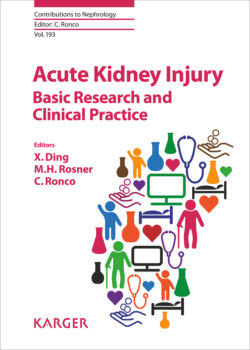Читать книгу Acute Kidney Injury - Basic Research and Clinical Practice - Группа авторов - Страница 47
На сайте Литреса книга снята с продажи.
Can Biomarkers Be Used to Guide Therapy?
ОглавлениеUltimately the desired aim of integrating AKI biomarkers into clinical practice is to improve clinical outcomes with one of the driving forces being early recognition and hence, timely intervention. However, a potential application of AKI biomarkers may be the enrichment of patient selection in clinical trials. Such integration may reduce misclassification of AKI and allow more accurate diagnosis improving statistical power in tandem with reducing sample size. Application of prognostic biomarkers may enhance the enrollment of patients likely to successfully meet trial end points enabling the use of specific therapies particularly as they may help identify a cohort at higher risk of developing AKI, for example. This is of particular value. Of late, such trial enrichment has indeed been employed with success. The PrevAKI trial examined the implementation of a care bundle in cardiac surgery patients deemed at high risk for AKI. Of 1,046 patients identified, 882 were screened of which 111 were unsuitable. This left a cohort of 771 patients, 276 of whom were randomized following risk stratification with a biomarker (TIMP-2/IGFBP-7) [51]. The high-risk group were defined by TIMP-2.IGFBP-7 >0.3 with a primary endpoint defined as the rate of AKI as defined by KDIGO criteria within 72 h of surgery. AKI was significantly reduced with the intervention compared to controls (55.1 vs. 71.7%; [95% CI 5.5–27.9]; p = 0.004). The implementation of the bundle resulted in significantly improved hemodynamic parameters at different time points (p < 0.05), less hyperglycemia (p < 0.001) and use of ACEi/ARBs (p < 0.001) compared to similar parameters in controls. Rates of moderate to severe AKI were also significantly reduced by the intervention compared to controls, although in over 80% of cases AKI was defined by changes in urine output alone rather than SCr criteria or both, which accounted for about 5%. However, no effects were seen on 30-day outcomes including mortality. Certainly if this biomarker approach were not employed in this study, then a far greater sample size would have been needed to achieve the desired statistical power and this may have made the approach untenable.
Even more recently, a similar study in major non-cardiac surgery again demonstrated that biomarker-triggered KDIGO care bundle implementation translated into improved outcomes. Subgroup analysis demonstrated a significantly reduced incidence of AKI after major abdominal surgery together with reduced length of stay [52]. Although these are small single-centre studies, they may hold great promise in terms of risk stratification and directing therapy to those individuals at risk of AKI but, importantly those who exhibit a degree of renal stress. It may be that the benefits are not seen immediately but may be reflected in the long-term reduction in CKD and the inherent risks associated with the development of chronic kidney disease.
